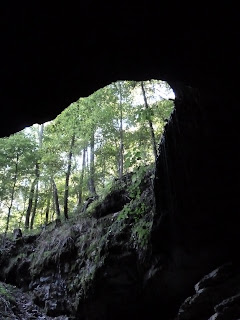Day 68: Sunday, September 12, 2010
Mammoth Cave National Park
That night it was actually hard to sleep because of the excessive mooing of the herd of cows dusting the fields and hills bordering the campsite. Consequently, I was attacked by a serious fit of the giggles. Who knew cows were this social after dark? But they were gone in the morning and we never saw them again.
The next day was devoted to exploring Mammoth Cave National Park, the largest and longest underground cave system in the world, and, sadly, pretty much the only reason tourists stop in Kentucky.
After my experience at Wind Cave, I was extremely excited for Mammoth Cave. I had already ascertained that I was enough of a wacko to adore spelunking—the combination of adventure, geology, and earth science apparently really interest me. 
Upon entering the Visitor Center, we migrated over to a small podium under a prominent white banner bearing the slogan: Eliminate White Nose Syndrome! I thought it was some sort of creative racial slur. It turns out that White Nose Syndrome is a condition that is wreaking havoc upon the bat populations across the United States—from New England down to the South, and as far west as Oklahoma. Upon entering a cave, the fungus dusts the noses of the bats, turning them white. The fungus then grows and irritates the bats to the point that they wake up from hibernation, upsetting their natural cycle, and driving them out of the cave in the dead of winter to hunt for nonexistent food. When hunting and
foraging prove unfruitful, they die from malnourishment. While in most cases, the fungus spreads from bat to bat, other animals (including humans) are responsible for its continued spread across the nation.
The frightening thing is that the fungus spores can live for up to five years by themselves! So if you have been in a cave in the last five years, the Park Rangers ask to decontaminate any items you may have worn during the previous visit. For us that meant our shoes and camera. I'm sure it must have been somewhat frightening to the other tourists, the three of us taking off our shoes and dunking them and letting them sit in tubs of disinfectant.
Our tour group was definitely over 100 people—substantially larger than the previous tour. We were bused over to the large sinkhole in which was the original entrance to Mammoth Cave. Today the cave system is known to include over 367 miles of passageway—over twice the length of the second longest, Jewel Cave in South Dakota. 
Much of the cave system is covered by a sandstone capstone, which has dissolved in parts over the years due to continued water seepage. As these cracks widen and deepen, the acidity from the groundwater erodes the sandstone, and eats into the limestone layers beneath. The Green River is the main river responsible for much of the Mammoth Cave system. As the river level sinks, the groundwater table rushes downwards as well, dissolving rock along the way and forming extensive cave passages at varying depths.
According to our tour guide, there are three distinct (somewhat ominous-sounding) sections in Mammoth Cave: living cave, dormant cave, and dying cave. Living cave is identified by the presence of water. At the entrance of the cave are vertical shafts and narrow staircases that lead further and further down underground, dampness and puddles exacerbating the journey. At one point I reached out my hand blindly forward, groping for the wall, and instead flinched as I came into contact with the slimy, grimy cave wall. From then on, of course, I purposely grabbed the wall. The presence of moisture means there are different colored algae and fungi and some small cave-dwelling creatures, several of which are both endangered and eyeless, like the Kentucky cave shrimp. 
Dormant cave is distinguished by enormous caverns large enough to fit our entire group comfortably. These 'rooms' are the result of layers of limestone that have buckled under the pressure of the ceiling above it. As each layer crumbles, it supports the layer above it, allowing the ceiling to extend a bit further, and leaves chunks of rock the size of cars laying strewn about. In one such 'room', Edwin Booth recited Hamlet to a lucky tour group (hopefully not in its entirety). 
Dying cave is the oldest part of the cave, as its name suggests. The most famous feature at this end is the Frozen Niagara, an impressive display of the beauty in dripping limestone.
At one point, the tour guide called out, "Who can tell me the difference between this part of the cave and the cave at the entrance?" A hillbilly old man drawled out, "About twelve dollars!" Under those overalls, he was sharp. The tour guides chuckled and asked if they could use that in their following tours. "We're always looking for more material!"
Following our time in the cave, we hiked through the Park to the Main Entrance, past where the River Styx flows through the cave, up to Sunset Point. We were quite surprised to find Asian bamboo in the woods.
As we started to walk back to the now-deserted parking lot, we ran into the midst of a group of deer, bounding across the lawn to graze. There were a few fawns in tow and it was amazing seeing those thin, furry legs prancing around happily.
Kentucky was a good time.






No comments:
Post a Comment